Topic 4 - Priority Queues
Priority QueueA priority queue is an abstract data type which is like a regular queue or stack data structure, but where additionally each element has a "priority" associated with it. It basically supports two operations: remove the maximum and insert.
1 API¶
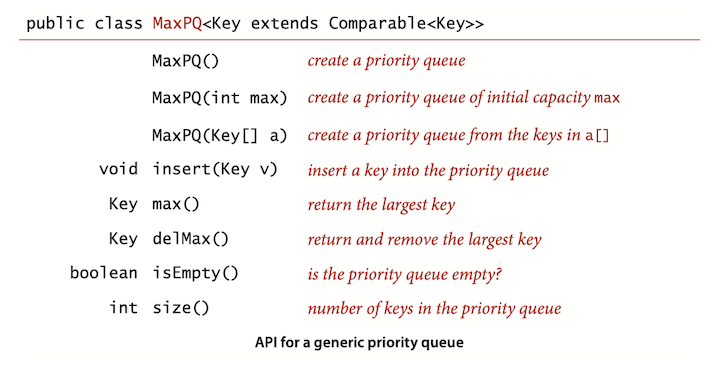
Question
Q: The purpose of Binary Heap: Why exactly don’t we just sort and then consider the items in increasing order in the sorted array?
- In some data-processing examples such as TopM and Multiway, the total amount of data is far too large to consider sorting (or even storing in memory).
- In other examples, all the data does not even exist together at any point in time.
2 Elementary implementations¶
Array representation (unordered)¶
Perhaps the simplest priority-queue implementation is based on pushdown stacks. The code for
click here
public class UnorderedMaxPQ<Key extends Comparable<Key>> {
private Key[] pq; // pq[i] = ith element on pq
private int N; // number of elements on pq
@SuppressWarnings("unchecked")
public UnorderedMaxPQ(int capacity) {
pq = (Key[]) new Comparable[capacity];
}
public boolean isEmpty() {
return N == 0;
}
public void insert(Key x) {
pq[N++] = x;
}
public Key delMax() {
int max = 0;
for (int i = 1; i < N; i++)
if (less(max, i))
max = i;
exch(max, N - 1);
Key max_element = pq[--N];
pq[N] = null; //null out entry, to prevent loitering
return max_element;
}
private void exch(int i, int j) {
Key swap = pq[i];
pq[i] = pq[j];
pq[j] = swap;
}
private boolean less(int i, int j) {
return pq[i].compareTo(pq[j]) < 0;
}
}
Array representation (ordered)¶
Another approach for
Linked-list representations¶
Analysis¶
Order of growth of worst-case running time for priority-queue implementations:
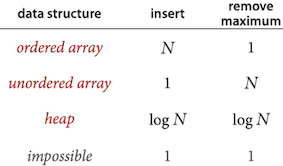
3 Heap definitions¶
A binary tree is heap-ordered if the key in each node is larger than or equal to the keys in that node’s two children (if any).
The largest key in a heap-ordered binary tree is found at the root.
A binary heap is a collection of keys arranged in a {complete} heap-ordered binary tree, represented in level order in an array (not using the first entry).
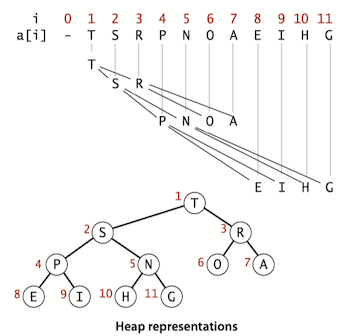
- In a heap, the parent of the node in position k is in position ⎣k/2⎦ and, conversely, the two children of the node in position k are in positions 2k and 2k + 1.
- we can travel up and down by doing simple arithmetic on array indices: to move up the tree from a[k] we set k to k/2; to move down the tree we set k to 2k or 2k+1.
- The height of a complete binary tree of size N is ⎣ \lg N ⎦ .
Question
Q. Why not use a[0] in the heap representation?
A. Doing so simplifies the arithmetic a bit.
4 Algorithms On Heaps¶
Promotion in a heap¶
Scenario: Child's key becomes larger key than its parent's key.
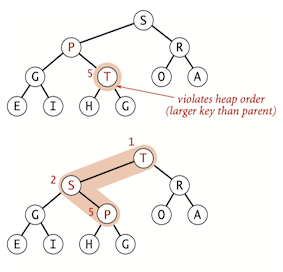
To eliminate the violation:
- Exchange key in child with key in parent.
- Repeat until heap order restored.
private void swim(int k) {
while (k > 1 && less(k / 2, k)) {
exch(k / 2, k);
k = k / 2;
}
}
Insertion in a heap¶
- Insert: Add node at end, then swim it up.
- Cost: At most 1 + \lg N compares.
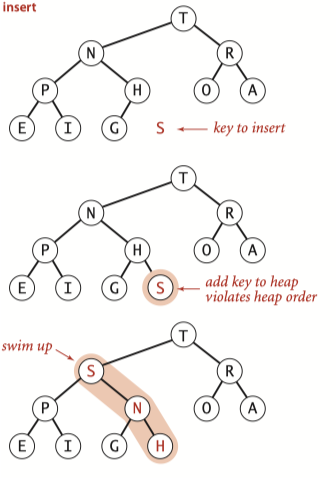
public void insert(Key v) {
pq[++N] = v;
swim(N);
}
Demotion in a heap¶
Scenario: Parent's key becomes smaller than one (or both) of its children's.
To eliminate the violation:
- Exchange key in parent with key in larger child.
- Repeat until heap order restored.
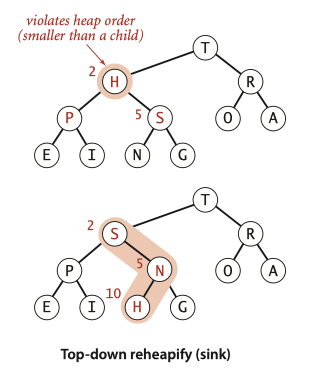
private void sink(int k) {
while (2*k <= N) {
int j = 2*k;
if (j < N && less(j, j+1)) j++;
if (!less(k, j)) break;
exch(k, j);
k = j;
}
}
Delete the maximum in a heap¶
- Delete max. Exchange root with node at end, then sink it down.
- Cost. At most 2 \lg N compares.
public Key delMax() {
Key max = pq[1];
exch(1, N--);
sink(1);
pq[N + 1] = null;
return max;
}
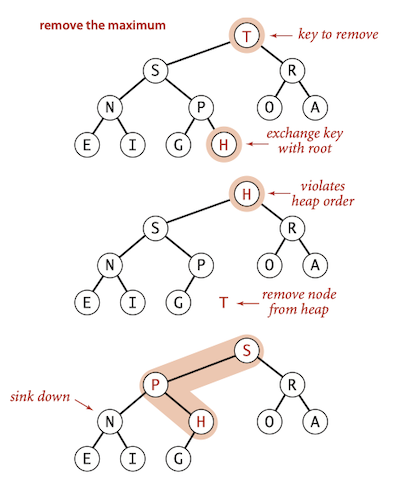
Click Here
public class MaxPQ<Key extends Comparable<Key>> {
private Key[] pq; // pq[i] = ith element on pq
private int N; // number of elements on pq
@SuppressWarnings("unchecked")
public MaxPQ(int capacity) {
pq = (Key[]) new Comparable[capacity + 1];
}
public void insert(Key v) {
pq[++N] = v;
swim(N);
}
public Key delMax() {
Key max = pq[1];
exch(1, N--);
sink(1);
pq[N + 1] = null;
return max;
}
public boolean isEmpty() {
return N == 0;
}
private void swim(int k) {
while (k > 1 && less(k / 2, k)) {
exch(k / 2, k);
k = k / 2;
}
}
private void sink(int k) {
while (2 * k <= N) {
int j = 2 * k;
if (j < N && less(j, j + 1)) j++;
if (!less(k, j)) break;
exch(k, j);
k = j;
}
}
private void exch(int i, int j) {
Key swap = pq[i];
pq[i] = pq[j];
pq[j] = swap;
}
private boolean less(int i, int j) {
return pq[i].compareTo(pq[j]) < 0;
}
}
6 Heap Sort¶
Heapsort use any heap-based priority queue as the basis for a sorting algorithm by inserting a sequence of items, then successively removing the smallest to get them out.
Heapsort breaks into two phases:
heap construction : reorganize the original array into a heap.sortdown : pull the items out of the heap in decreasing order to build the sorted result.
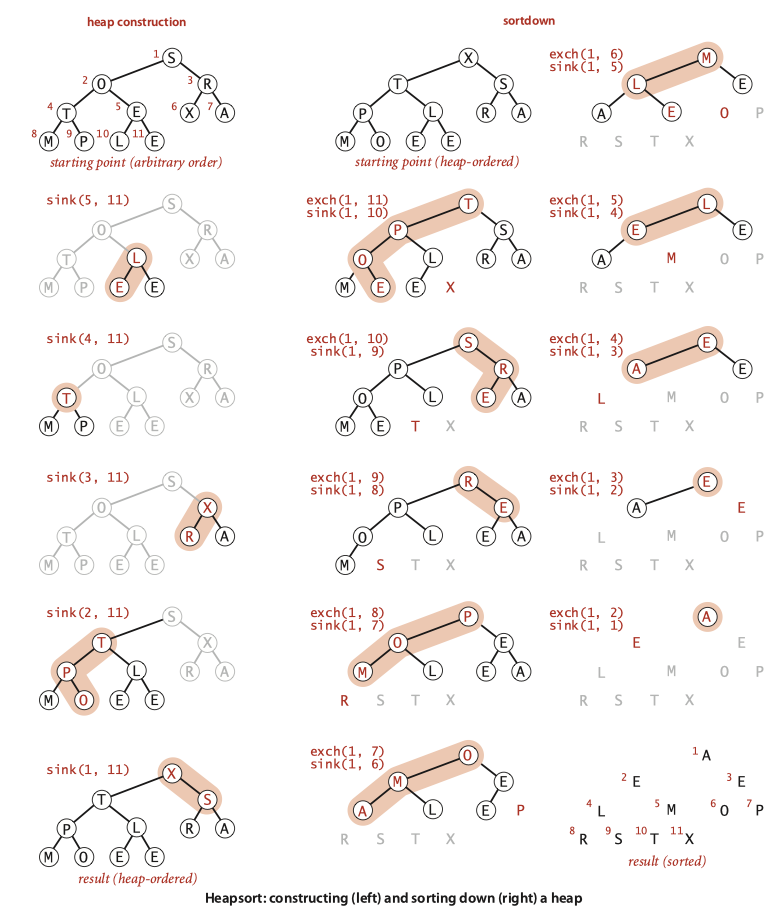
Heap construction¶
Build heap using bottom-up method:
- proceed from bottom to top, using
sink() to make subheaps. - The scan starts halfway, and ends at position 1.
public void heapify(
int N = a.length;
for (int k = N/2; k >= 1; k--)
sink(a, k, N);
}
Sortdown¶
Sortdown: repeatedly delete the largest remaining item.
- Remove the maximum, one at a time.
- Leave in array, instead of nulling out.
while (N > 1) {
exch(a, 1, N--);
sink(a, 1, N);
Complete Code for Heap Sort:
public static void sort(Comparable[] a) {
int N = a.length;
for (int k = N/2; k >= 1; k--)
sink(a, k, N);
while (N > 1) {
exch(a,1, N--);
sink(a, 1, N);
}
}
Analysis¶
- Heap construction uses \le 2 N compares and exchanges.
- Heapsort uses \le 2 N \lg N compares and exchanges.
Heapsort is optimal for both time and space, but:
- Inner loop longer than quicksort’s.
- Makes poor use of cache memory.
- Not stable.